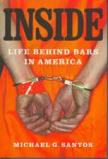One Tough Community
“We don’t care about your future. You’re an inmate, and all inmates are the same.” Such were the bleak words of a prison official addressed to Michael Santos, who is serving time in a federal facility. The official, a “unit manager,” was angry with him for writing about what he rightly calls “these closed communities.” But prisons are just that—dark, violent communities shut off from the world—a circumstance that makes the abuses within them all the more difficult to expose. Fortunately, Mr. Santos persevered in describing what takes place behind bars. The result is Inside: Life Behind Bars in America, a remarkably full picture of a prison system that has run amok.
The prison industry—–it is indeed an industry—has expanded so rapidly at both the state and the federal levels that the United States has the highest incarceration rate of any country in the world. Fueled largely by the 1970’s anti-drug initiatives that began with the Rockefeller drug laws in New York State and then spread throughout the nation, 2.2 million men, women and children are confined behind bars on any given day. Because the prison industry offers secure jobs, moreover, private prison companies like the Corrections Corporation of America and powerful correctional officers’ unions press for the construction of still more jails and prisons.
As to his own long sentence, Mr. Santos makes no excuses for his drug-selling mistakes. His cocaine distribution activities brought him at age 23 a four-decades-long sentence. Now in his 40’s, he does not expect to be out until 2013. Nevertheless, aided by his own native intelligence, a knowledgeable mentor and one progressive warden, he has gone far in self-rehabilitation.
With only a high school diploma when sentenced, he has since earned both a bachelor’s and a master’s degree from accredited outside institutions. He thus stands out as a rare example of a person who discovered not only his better self while incarcerated, but also his vocation as a writer.
Mr. Santos befriended many of the inmates at the facilities in which he has served time and, with their permission, he tells their stories as well as his own. Many are gang members, and the accounts of their lives are described in their own street language, a language replete with four-letter words and often gory descriptions. The violence they knew before prison has for the most part been aggravated by the brutal conditions of their confinement. Those same conditions can also negatively affect prison personnel, who sometimes succumb to bribery and revenge in their dealings with inmates. Reports by organizations like Human Rights Watch have documented various abuses perpetrated by correctional personnel.
But abuse takes place among inmates too, and so dangerous is the climate for weaker inmates that many request to be placed in protective custody, a form of solitary confinement. Those who remain in the general prison population easily fall prey to extortion and sexual violence—a situation especially dangerous for the mentally ill, who become easy targets. Prisons can thus present far more perils than the meanest streets. As Mr. Santos observes, prison life overall represents a “culture in its own right,” one that discourages incarcerated people from “thinking they can become anything more than prisoners.”
A move is now afoot among prison reform advocates to prepare inmates in more concrete ways for their eventual re-entry into society. But effective measures require significant funding, and while funding is always available for more security, the same is not true of meaningful educational and rehabilitative opportunities. As for what happens when prisoners are released, even basic pre-release procedures—such as ensuring that inmates be enrolled in Medicaid beforehand—are frequently lacking, to say nothing of the residential drug treatment that many need on returning to their communities.
The few positive changes that took place among the people Mr. Santos describes came about mostly because of advancing age or illness. Crip Tank (not his real gang name), whom he had met in the early years of his incarceration at a maximum security facility, reappears later in the book in the same minimum security facility as the author. Crip Tank was by then in a wheelchair, ill with a life-threatening disease that might have been curable had he received medical treatment in the disease’s earlier stages. But as Mr. Santos notes, the response to medical problems in most prisons tends to be little more than Ibuprofen. Illness and age have at least turned Crip Tank’s thoughts to his children, whom he now hopes to help avoid the kind of gang-driven life that brought him to prison. So too with another inmate, whom the author calls Fox. Not only has Fox begun saving money from his small in-prison job for use at his eventual release, he also volunteers in the Save Our Youth Program aimed at deterring juveniles from early involvement in crime. But interior changes of this kind are almost as rare as the author’s own.
At the end of his book, Mr. Santos argues for reforms in the criminal justice system that would move it away from the warehousing of prisoners that prevails today. Instead, he argues, citing a famous address by Chief Justice Warren Burger, prisoners should be given the opportunity to “earn and learn” their way to freedom through meaningful incentives in the way of education and training. But again, such incentives require both funding and enlightened administrators. Currently, as he puts it, “there is no authentic interest in...encouraging prisoners to distinguish themselves with excellence.” Reform advocates have also suggested that governments pay more attention to the poor neighborhoods from which many inmates come, neighborhoods that lack meaningful job opportunities.
In other words, deter criminal activity before it takes hold in the lives of poor inner-city residents by giving them the opportunity to earn a living wage. In the meantime, the prison industry continues to grow all too rapidly.
This article also appeared in print, under the headline “One Tough Community,” in the January 1, 2007, issue.








